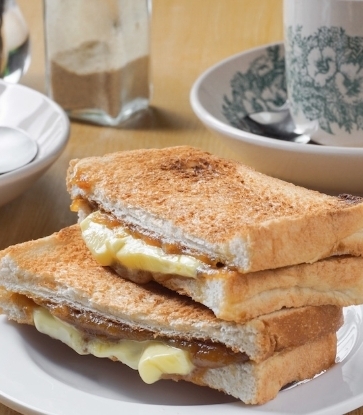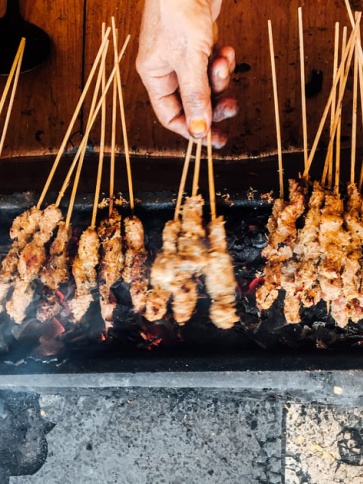But since the rise of the industrial and commercial sectors, as well as people turning increasingly to Western cuisines, new choices were born for morning and late-night meals. In the skyscraper-filled cities, congee served with sides has become strikingly quaint.
Congee can be made in two styles, plain or flavoured with sweet potato. The former is congee at its purest, while sweet potato congee took shape at a time when resources like rice were scarce in the 1950s and 1960s. People withheld a part of white rice and added sweet potato, cut into chunks or thin slices, in their congee to fight hunger.

Taiwanese congee is distinct from its Cantonese counterpart. The latter is cooked with tofu skin or gingko nut, but there is nothing other than rice in the plain congee of Taiwan. Compared to Cantonese congee which is cooked until the grains fully break down, the rice and the thickness of the liquid are paramount for Taiwanese people: raw home-grown japonica rice is added to a pot, cooked in water until the centre of the rice remains a little hard, and the grains still separate from the boiling liquid.
At this point, the heat is turned off and the pot is covered for half a minute. Within this brief period, the rice softens and the liquid thickens. The two slowly become one. A translucent thin skin is formed on top of the rice and the congee is ready to be served.
Despite the dish’s connection to an era of scarcity, the Taiwanese don’t settle on just any sweet potato to cook up a yummy bowl of congee. Generally, the criteria include variety, size and appearance. Yellow sweet potato works better than its red sibling. The latter has a higher sugar content and breaks more easily, which messes up the presentation and texture when paired with the side dishes.
How the tuber is cut could have a bearing to the outcome as well. Having the sweet potato in large chunks in the congee gives diners a sense of substantiality. But in reality, many shops take the opposite path, cutting it up into small bites to shorten cooking time and make it seem like they throw in a large amount of ingredients. By doing so, the joy of actually biting into the sweet potato is sacrificed. Appearance-wise, the dark spots on the tuber’s surface need to be peeled off. The cooked pieces should appear bright and smooth.

The range of sides that goes with congee is endless. Lovers of preserved will be spoilt for choice with options such as pickled cucumber, wheat gluten, pickled turnip, pickled white gourd, fermented bean curd, dried bamboo shoot, salted clam, salted duck egg, meat floss and all sorts of fried bean sticks. All condiments are palate refreshers with strong sweet or salty tastes.

In many established Taiwanese restaurants famous for more elaborate creations, the tradition of congee with sides is kept alive. On one hand, it shows their integrity to the past; on the other hand, congee is also a good choice for the elderly and infants who don’t have strong teeth.
Memories Of The 1990s
In the 1990s, Taiwan benefitted from a booming stock market. Many Taiwanese were out and about late at night, immersing themselves in the thriving nightlife scene. After a great time at karaoke or the cinema, congee with sides was the most obvious late-night supper option.
There was once a whole street in Taipei lined with joints specialising in the quick, straightforward fare. Open 24hours a day, many customers would drive by and get their fix of rice porridge. The roads were soon jammed with cars, prompting the shops to provide a free valet parking service.
Subsequent fluctuations of the stock market slowed down the hustle and bustle at night. Law enforcement on drink-driving has also tightened. The once flourishing “congee with sides street” has only three to four shops surviving, turning on the lights every night to serve diners eager to reminisce the bygone days.
This article was written by Chen Ching Yi and translated by Vincent Leung. Click here to read the original version of this story.


















